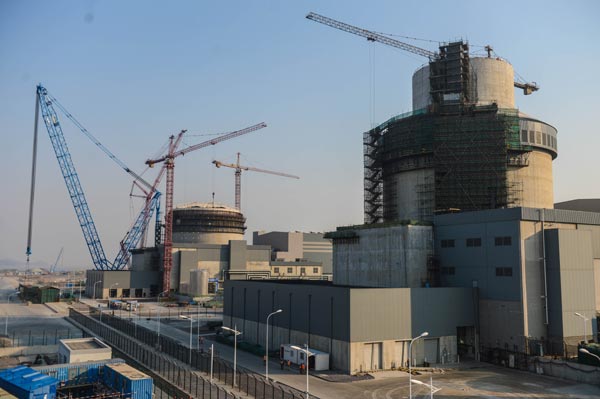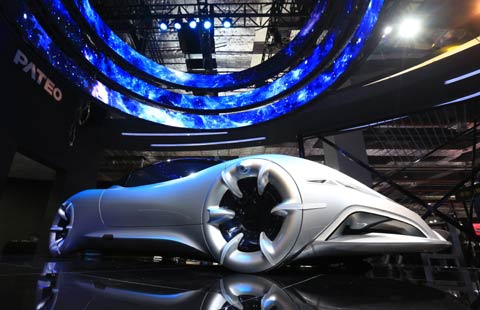'Crucial year' for nuclear energy sector
Updated: 2015-04-23 07:04
By Lyu Chang(China Daily)
|
||||||||
|
 |
|
The Sanmen nuclear power plant under construction in Zhejiang province. China has 23 nuclear reactors in operation and 26 under construction. [Photo/Xinhua] |
Eight new nuclear reactors will go online this year and six to eight others will be approved, a senior industry official said on Wednesday.
"The year of 2015 marks an important year for China to resume its nuclear power program after Japan's nuclear crisis," Zhang Huazhu, chairman of the China Nuclear Energy Association, said during the 11th China International Exhibition on Nuclear Power Industry 2015 in Beijing.
The nation's installed nuclear capacity will soon approach 50 gigawatts. There are 23 nuclear reactors in operation and 26 under construction, the association said.
Last year, nuclear generation rose 18.9 percent to 130.6 billion kilowatt-hours, but that figure only accounted for 2.4 percent of the country's total power generation, leaving room for growth, according to the association.
Zhang said that nuclear power will play a bigger role in optimizing China's energy mix, coping with climate change and cutting air pollution.
"In the coming decade, China will maintain a rapid pace of nuclear power development so that it can reach the target of nuclear installations by 2020 and make better use of energy," Zhang said.
Earlier this month, the pilot Fuqing nuclear power project in Fujian province, using the Hualong One technology, a domestically developed third-generation nuclear reactor design, got the green light from the State Council (cabinet).
The approval, which was granted during an executive meeting on April 15 presided over by Premier Li Keqiang, will improve the competitiveness of the country's equipment manufacturing on the global stage, according to a statement released after the meeting.
The technology was developed by two nuclear power giants-China National Nuclear Corp and China General Nuclear Power Group.
The approval, which came after construction began at the Hongyan River nuclear power plant in Liaoning province in March, is set to make Fuqing the first nuclear project that will use the third-generation nuclear technology.
China's nuclear program was suspended after the Fukushima nuclear disaster in Japan four years ago.
The Fangchenggang nuclear power plant in the Guangxi Zhuang autonomous region, also using the Hualong One design, is likely to become the next project approved by regulators, experts from CGN said during the exhibition.
Other projects such as the Shidao Bay nuclear demonstration project in Shandong province will soon get approval as well, experts said.
The technology in the Shidao Bay plant is the CAP 1400, which is based on the advanced AP1000 pressurized water reactor introduced into China by United States-based Westinghouse Electric Corp, now owned by Japan's Toshiba Corp.
China's total investment in completed nuclear power projects dropped 6.6 percent to 56.9 billion yuan ($9.3 billion) in 2014, according to the association.

 Ten photos you don't wanna miss - April 23
Ten photos you don't wanna miss - April 23
 Concept cars in spotlight at Shanghai auto show
Concept cars in spotlight at Shanghai auto show Volcano erupts in southern Chile, belching ash, smoke into sky
Volcano erupts in southern Chile, belching ash, smoke into sky
 US returns ancient artifacts to Egypt
US returns ancient artifacts to Egypt
 Unusual libraries around the world
Unusual libraries around the world
 Chinese real estate deals in US topical forum
Chinese real estate deals in US topical forum
 Weird stuff you can buy on Taobao
Weird stuff you can buy on Taobao
 Top 5 wealthiest women in world's tech sector
Top 5 wealthiest women in world's tech sector
Most Viewed
Editor's Picks

|

|

|

|

|

|
Today's Top News
Nuclear cooperation proposal lauded
Furious 7 on track to be tops in China
As PayPal split looms, eBay plans to think small
China loves almonds from water-thirsty California
China sustains US cities: Bloomberg
Real estate investors may switch focus: panel
Obama submits nuclear energy cooperation deal with China
US urges Japan to handle wartime history in constructive way
US Weekly

|

|






